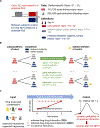A trajectory-informed model for detecting drug-drug-host interaction from real-world data
- PMID: 40456502
- PMCID: PMC12223795
- DOI: 10.1016/j.jbi.2025.104859
A trajectory-informed model for detecting drug-drug-host interaction from real-world data
Abstract
Objective: Adverse drug event (ADE) is a significant challenge to public health. Since data mining methods have been developed to identify signals of drug-drug interaction-induced (DDI-induced) or drug-host interaction-induced (DHI-induced) ADE from real-world data, we aim to develop a new method to detect adverse drug-drug interaction with a special awareness on patient characteristics.
Methods: We developed a trajectory-informed model (TIM) to identify signals of adverse DDI with a special awareness on patient characteristics (i.e., drug-drug-host interaction [DDHI]). We also proposed a study design based on an optimal selection of within-subject and between-subjects controls for detecting ADEs from real-world data. We analyzed a large-scale US administrative claims data and conducted a simulation study.
Results: In administrative claims data analysis, we developed optimally matched case-control datasets for potential ADEs including acute kidney injury and gastrointestinal bleeding. We identified that an optimal selection of controls had a higher AUC compared to traditional designs for ADE detection (AUCs: 0.79-0.80 vs. 0.56-0.76). We observed that TIM detected more signals than reference methods (odds ratios: 1.13-3.18, P < 0.01), and found that 36 % of all signals generated by TIM were DDHI signals. In a simulation study, we demonstrated that TIM had an empirical false discovery rate (FDR) less than the desired value of 0.05, as well as > 1.4-fold higher probabilities of detection of DDHI signals than reference methods.
Conclusions: TIM had a high probability to identify signals of adverse DDI and DDHI in a high-throughput ADE mining while controlling false positive rate. A significant portion of drug-drug combinations were associated with an increased risk of ADEs only in specific patient subpopulations. Optimal selection of within-subject and between-subjects controls could improve the performance of ADE data mining.
Keywords: Adverse drug event; Drug-drug interaction; Drug-drug-host interaction; Drug-host interaction; Patient characteristics.
Copyright © 2025 The Author(s). Published by Elsevier Inc. All rights reserved.
Conflict of interest statement
Declaration of competing interest The authors declare that they have no known competing financial interests or personal relationships that could have appeared to influence the work reported in this paper.
Figures






References
-
- CDC: Centers for Disease Control and Prevention, FastStats: Medication Safety Data, 2024, Available from: https://www.cdc.gov/medication-safety/data-research/facts-stats/index.html.
-
- Hughes JE, et al. Drug-drug interactions and the risk of adverse drug reaction-related hospital admissions in the older population, Br. J. Clin. Pharmacol 90 (4) (2024) 959–975. - PubMed
MeSH terms
Grants and funding
LinkOut - more resources
Full Text Sources
Medical

